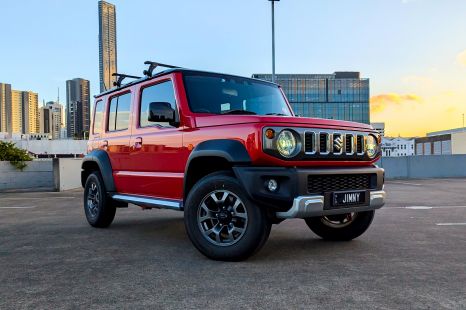

William Stopford
2026 Suzuki Jimny XL review
4 Hours Ago
The Audi RSQ8 isn't quite as ferocious as the RS badge would suggest, but there's no shortage of power or dynamic ability here.
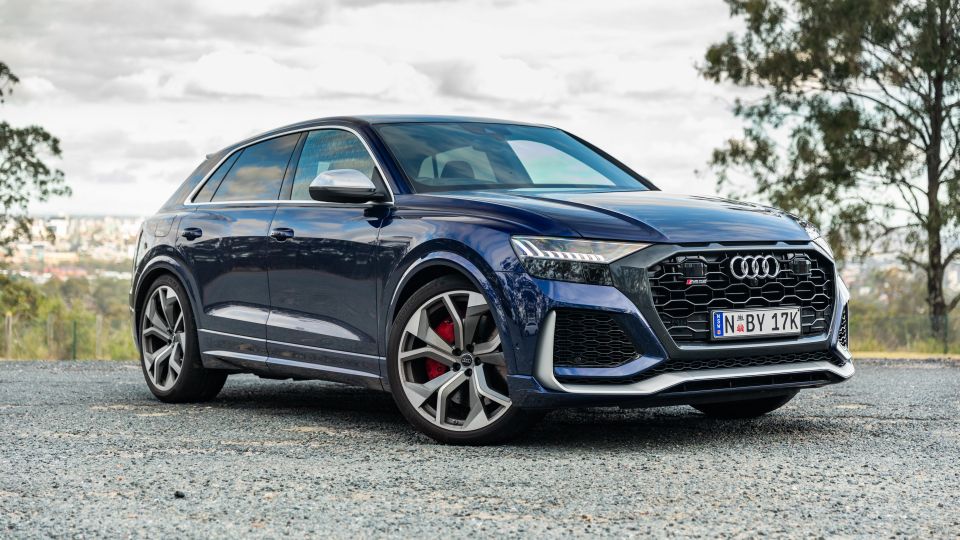
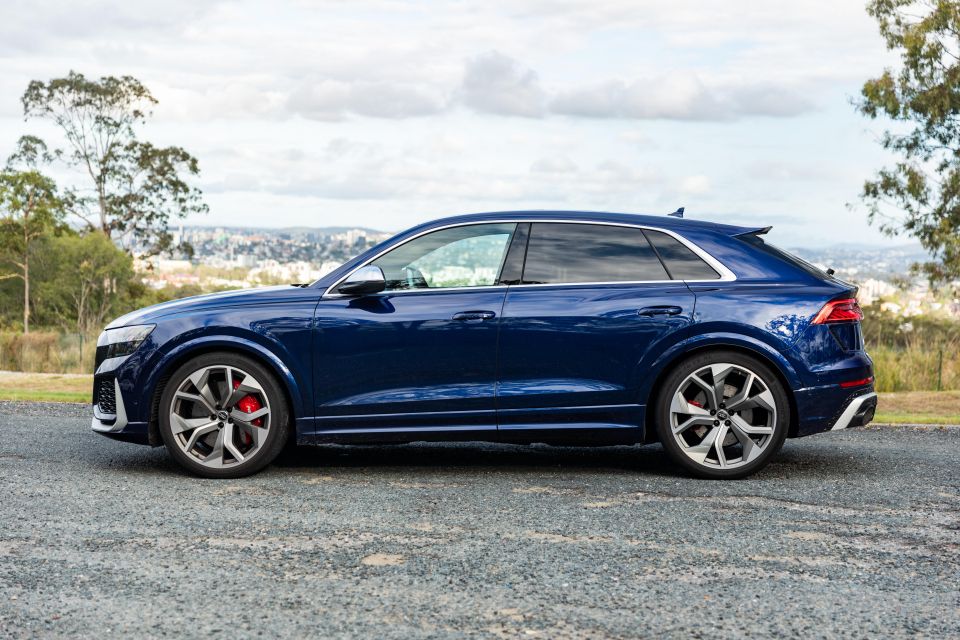

News Editor

News Editor


News Editor

News Editor
Where expert car reviews meet expert car buying – CarExpert gives you trusted advice, personalised service and real savings on your next new car.
This is an Audi with swagger.
The 2022 Audi RSQ8 is one of just two Audi SUVs to wear the vaunted RS badge, the RSQ3 being the other.
It sits at the very top of the Q8 tree, above the twin-turbo diesel V8 SQ8. That makes the RSQ8 Audi’s most expensive SUV.
Kudos to Audi’s designers for avoiding going down the same path as BMW and Mercedes-Benz. Audi’s Q3 Sportback and Q5 Sportback are more attractive than their hunchbacked German rivals, but they still closely resemble the Q3 and Q5 wagons. The Q8, however, doesn’t merely look like a sleeker Q7.

There’s not a bad line on the RSQ8, with an overall silhouette reminiscent of its cousin, the Lamborghini Urus. While Audi designs can sometimes be overly conservative bordering on bland, the RSQ8 looks fantastic with crisp, angular lines, subtly bulging hips, and a snazzy full-width lighting element down back.
In my eyes, it’s more attractive than a BMW X6 and a damn sight better-looking than the awkward Mercedes-Benz GLE Coupe. In RSQ8 guise, it’s further enhanced with enormous, concept car-sized 23-inch alloy wheels that somehow avoid looking ridiculous.
You’d buy an RSQ8 because you want the ultimate Audi SUV, or because you’re cross-shopping this with the likes of the BMW X6 M Competition and Mercedes-AMG GLE 63.
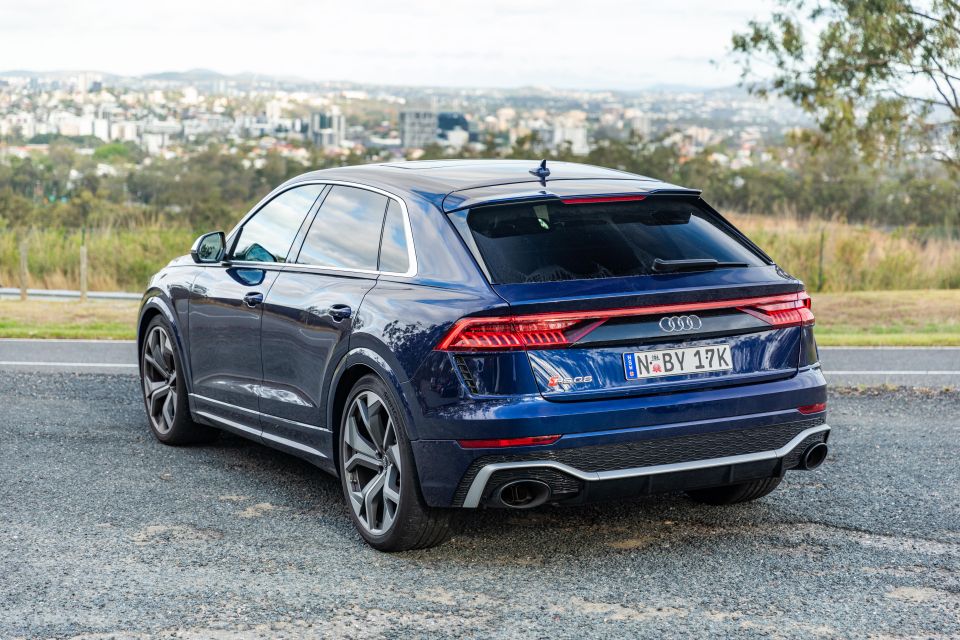
The RSQ8 is priced at $213,900 before on-road costs. It’s actually slightly cheaper than the RS6 Avant ($221,400) and the RS7 Sportback ($229,400).
There’s no SUV tax here then, more like an SUV rebate. That said, there are few other Audis more expensive than this. Only the S8 and discontinued R8 cost more, while there are no other Audi SUVs with higher price tags.
The RSQ8 undercuts the X6 M Competition ($218,900) and GLE 63 S Coupe ($243,400). It’s also considerably cheaper than the less powerful Porsche Cayenne Turbo Coupe, which is priced at $262,200 plus on-roads.
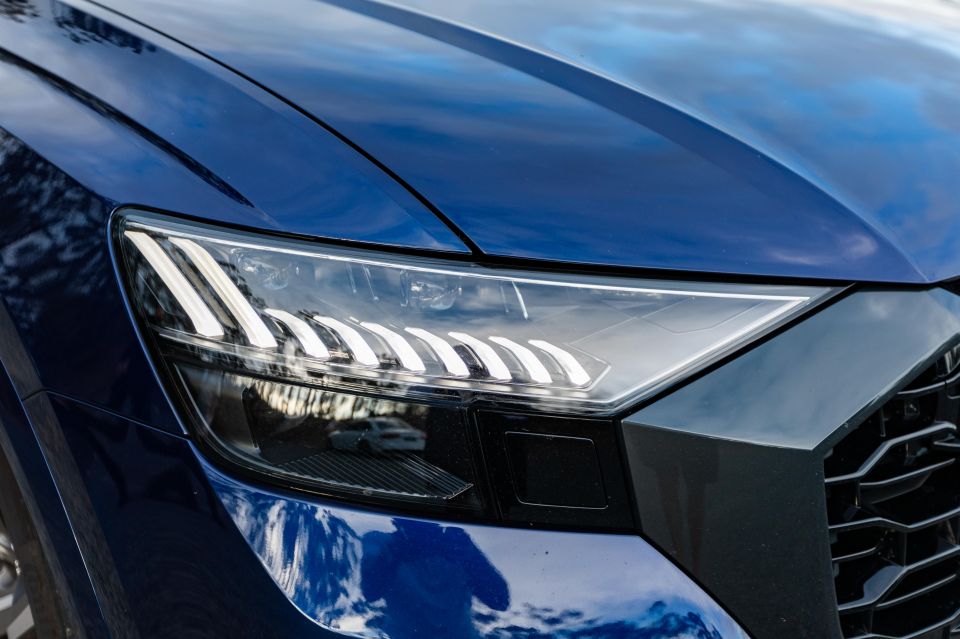
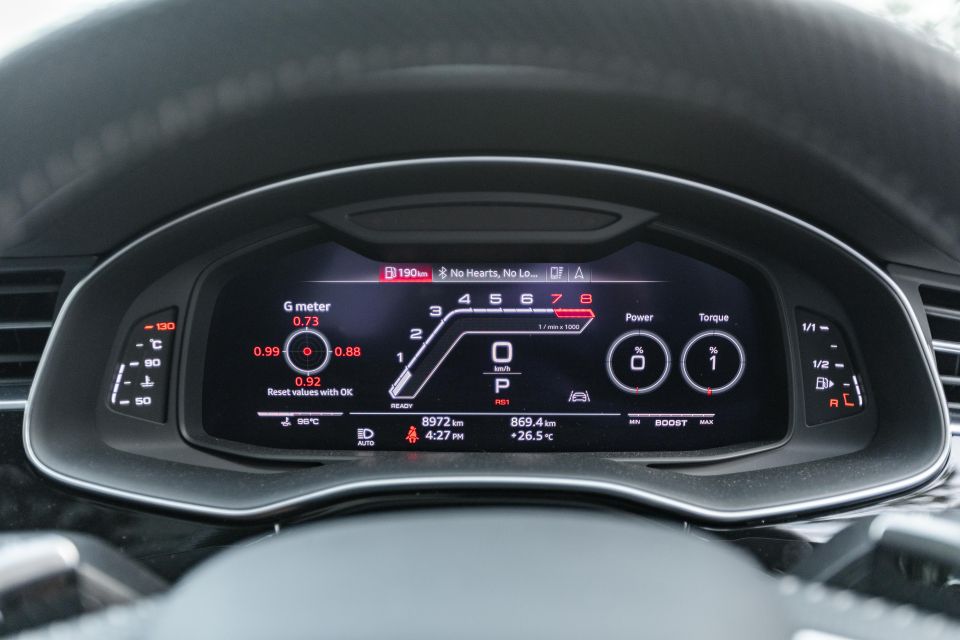
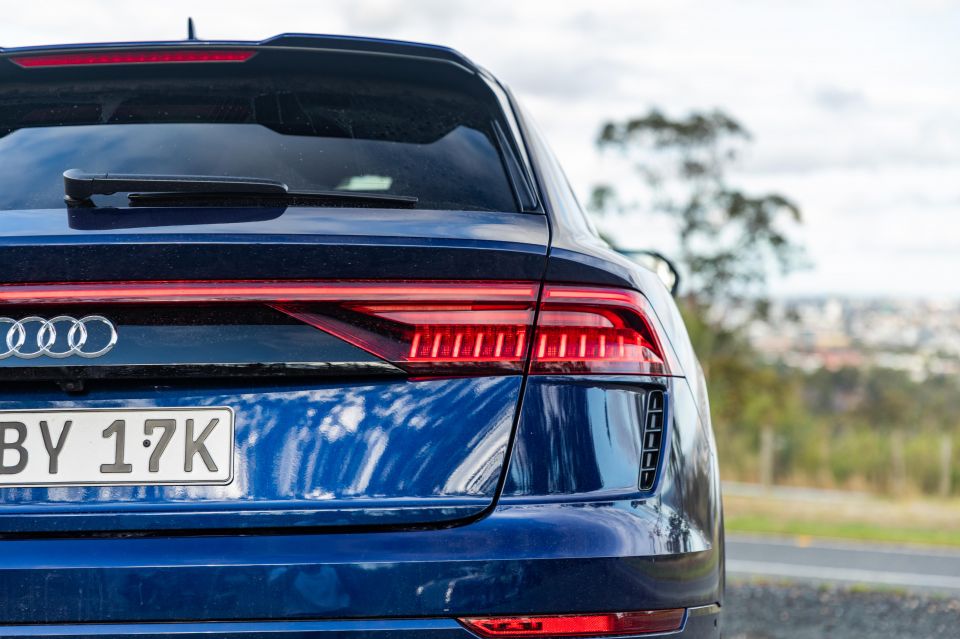
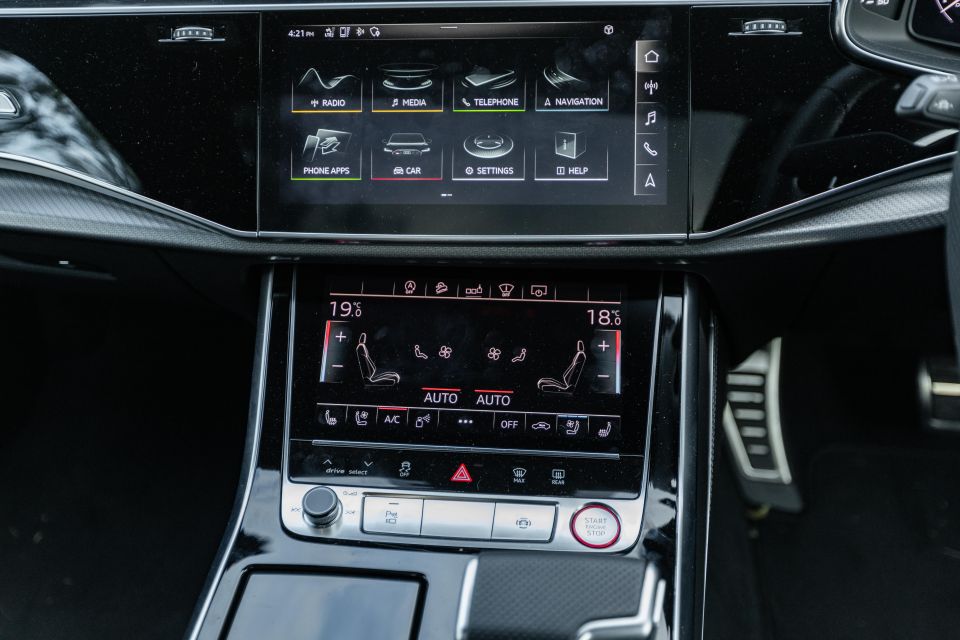
Buy your new car without the stress. It's fast, simple and completely free.

Great service from Travis and team, second time I have used this business would not hesitate to recommend them to anyone
Craig C.
Purchased a Ford Ranger in Sunshine Coast, QLD
CarExpert helped Craig save $7,224 on his Ford Ranger, now let us save you on your next new car.
Get your BEST priceOur tester came with Navarra Blue metallic paint, a matte aluminium exterior styling package, and matte titanium 23-inch alloy wheels, all of which are no-cost options.
Standard equipment on the RSQ8 includes:
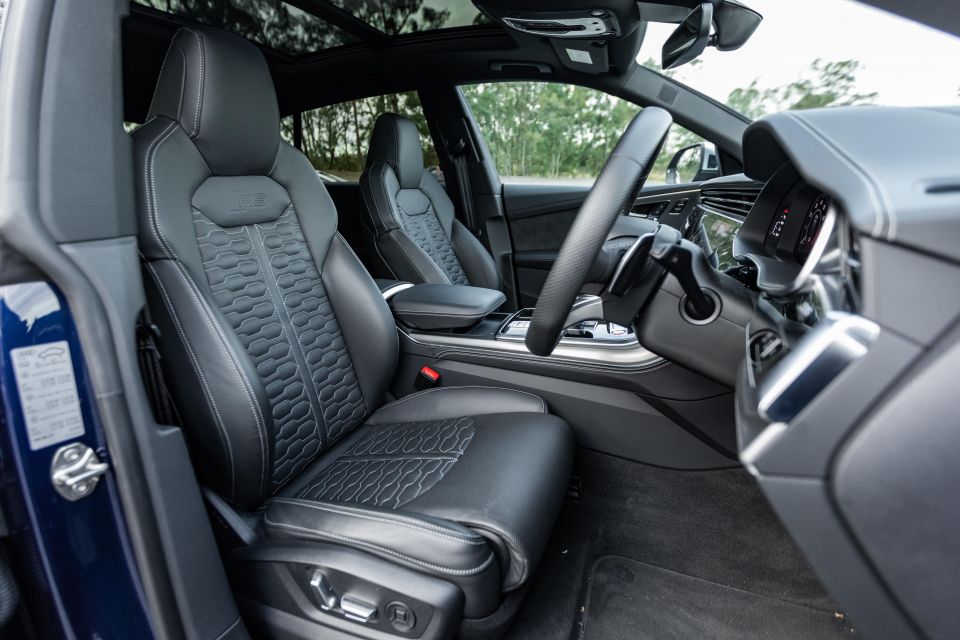
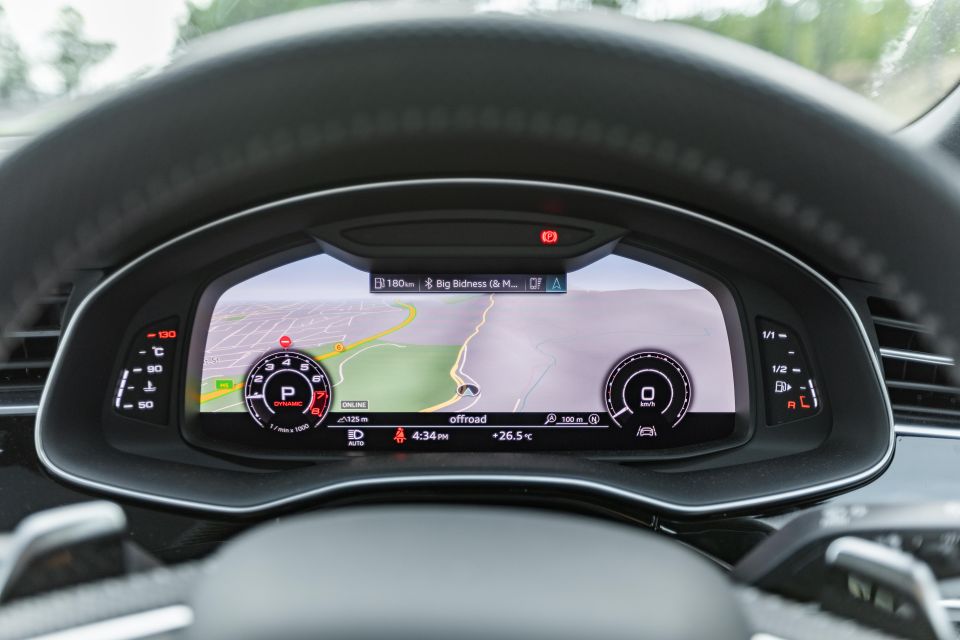
Performance hardware includes adaptive air suspension, four-wheel steering, active roll stabilisation, and the quattro sport differential that features a self-locking centre differential and a sport differential on the rear axle.
There are various design packages available, as well as the RS Dynamic Package Plus that adds ceramic brakes and a 305km/h top speed.
The optional Sensory Package adds a 23-speaker, 1920W Bang & Olufsen sound system, Alcantara headlining, and a massaging driver’s seat.
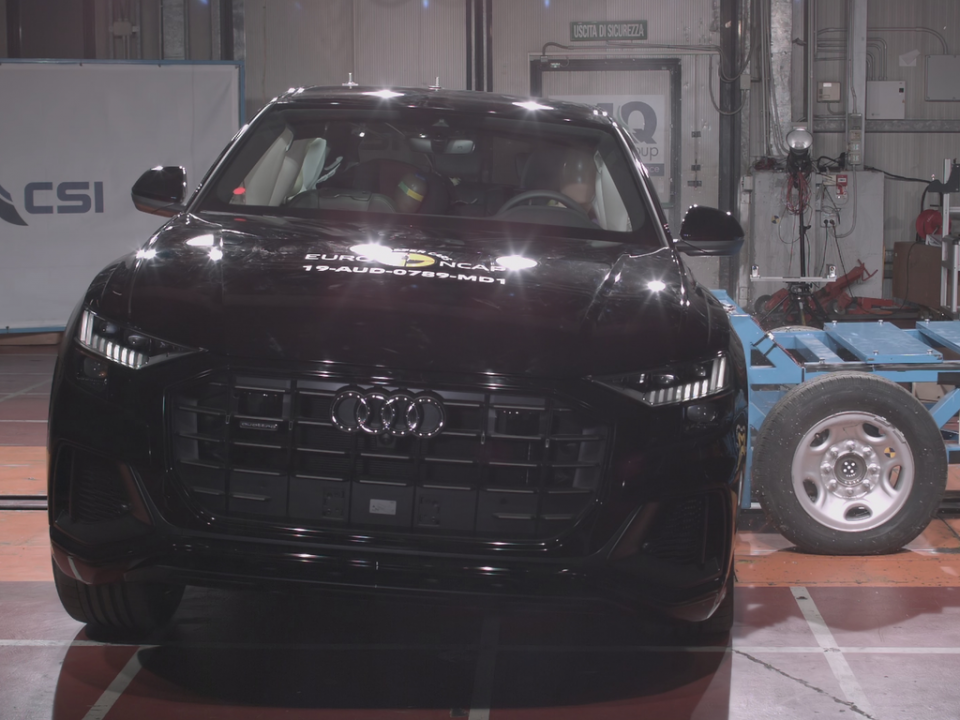
The RSQ8, like the SQ8, doesn’t technically have a rating from ANCAP. The Q8 upon which they’re based, however, boast a five-star rating based on testing conducted in 2018.
The Q8 scored 93 per cent for adult occupant protection, 88 per cent for child occupants, 71 per cent for vulnerable road users, and 75 per cent for safety assist.
Standard safety equipment includes:
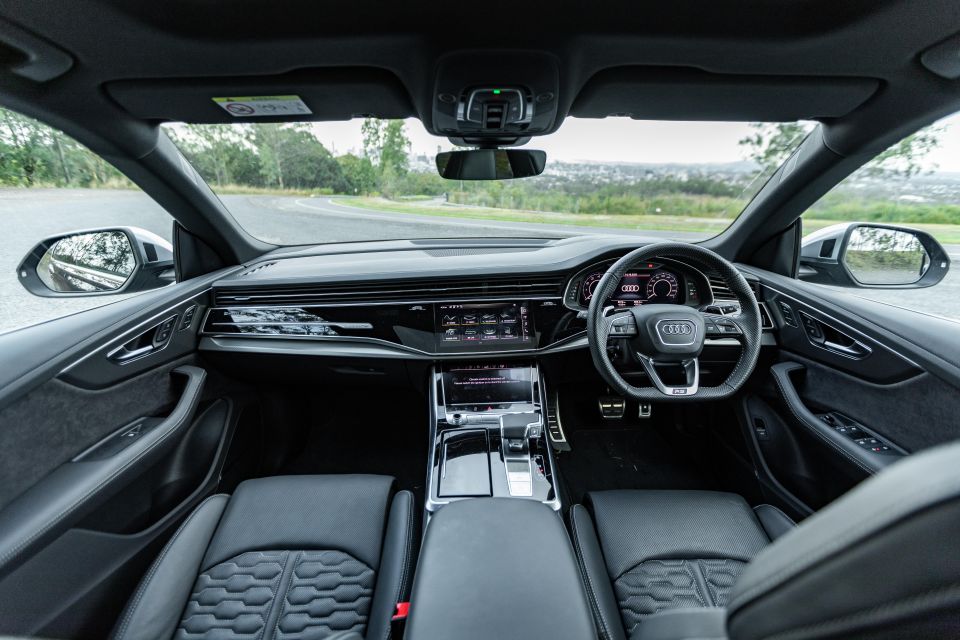
Audi’s interior design language can be conservative, but the RSQ8’s interior is pleasing to the eye.
There’s a much closer resemblance to the Q7 inside than out, but that’s no bad thing. The RSQ8 has the extended leather package as standard fit, which finds Nappa leather gracing the centre console, armrests, and dashboard. The comfortable, supportive seats, in contrast, are upholstered in Audi’s Valcona leather.
There’s extensive use of smudge-attracting gloss black trim but the execution is elegant and enhanced by the strips of ambient lighting. You can choose between dozens of colours and the ambient lighting is split into two different ‘levels’ – primary and contours – allowing you to present two different colours at a time.

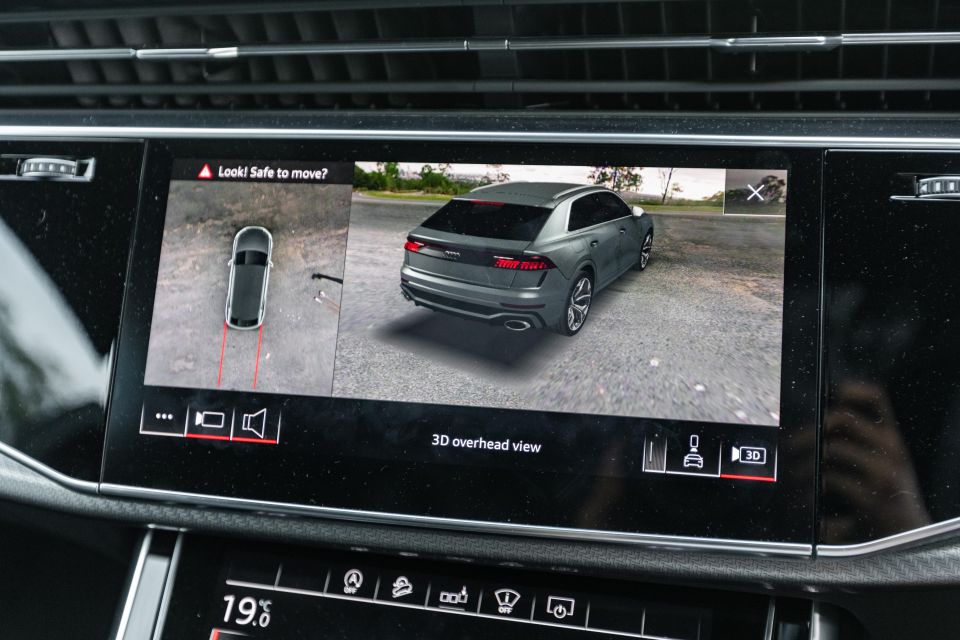
The touchscreen has honest-to-goodness haptic feedback in all but smartphone mirroring, and everything looks crisp and high-resolution. That includes the cameras, which isn’t a given at this price point (I’m looking at you, Lexus). Said camera system also includes a clever 3D mode, allowing you to swivel the depiction of the car around to see what’s around you.
Below the touchscreen is another touchscreen for the climate controls. While there’s nothing wrong with good old-fashioned buttons and knobs, the system works well and looks great to boot.
You grip a stubby shifter with a dimpled leather top and a chunky, leather-wrapped wheel with a squared-off base. The wheel feels tactile and well-sized, though the paddle shifters aren’t the swishest we’ve felt.
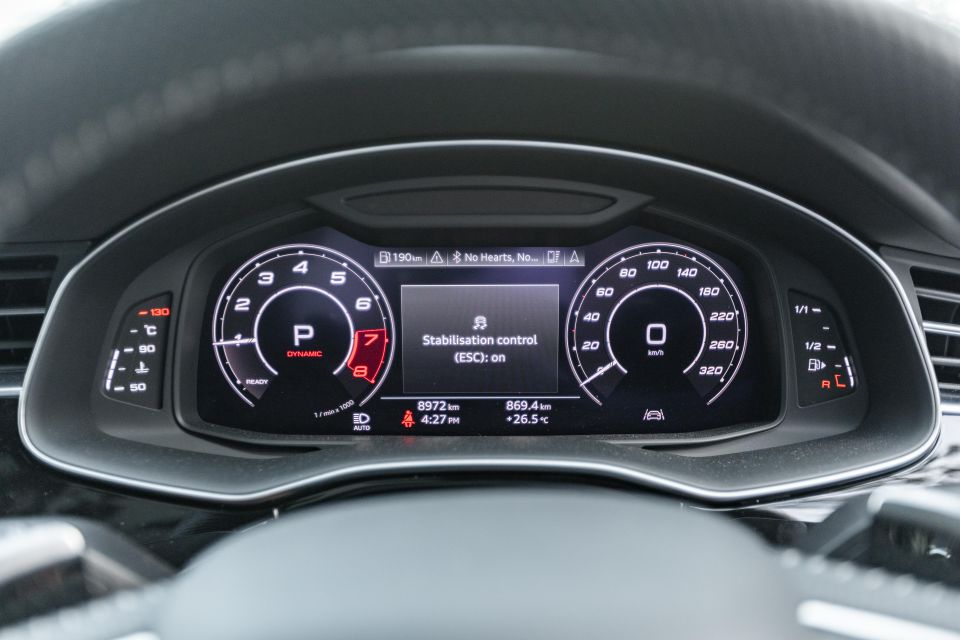

There are various parts in the RSQ8’s interior that can be found in Audis costing tens of thousands less. Some may bemoan the application of the Virtual Cockpit in the RSQ8, where it looks much the same as in lesser Audis, but I’m of the belief this is still one of the best digital instrument clusters out there regardless of the price point.
The selectable RS modes also bring a sportier instrument layout with additional information, including a G-force meter.
Less pleasing are the steering wheel controls, which have this clickety-clack feeling and ought to be more pleasantly damped.

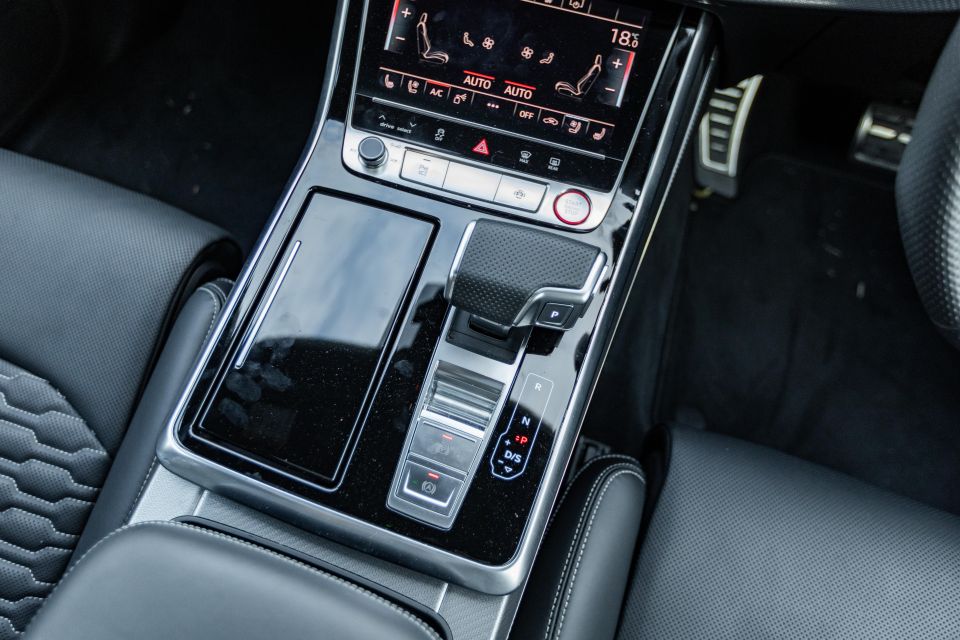
We’re glad the plastic fantastic drive mode selector found in many Audis has been banished, but it’s been replaced with two on-screen buttons that are just as small and unintuitive to use. Give us a rotary dial on the centre console, or even a Porsche-style, wheel-mounted selector.
There’s no centre console bin to speak of. Open the padded lid and you’ll instead find a wireless charging pad and a small storage slot, as well as USB outlets. There are two cupholders on the centre console.
The RSQ8 may have a racier roofline than the boxy Q7 but the second row still has ample headroom and legroom, not to mention comfortable seats like those in the front row.
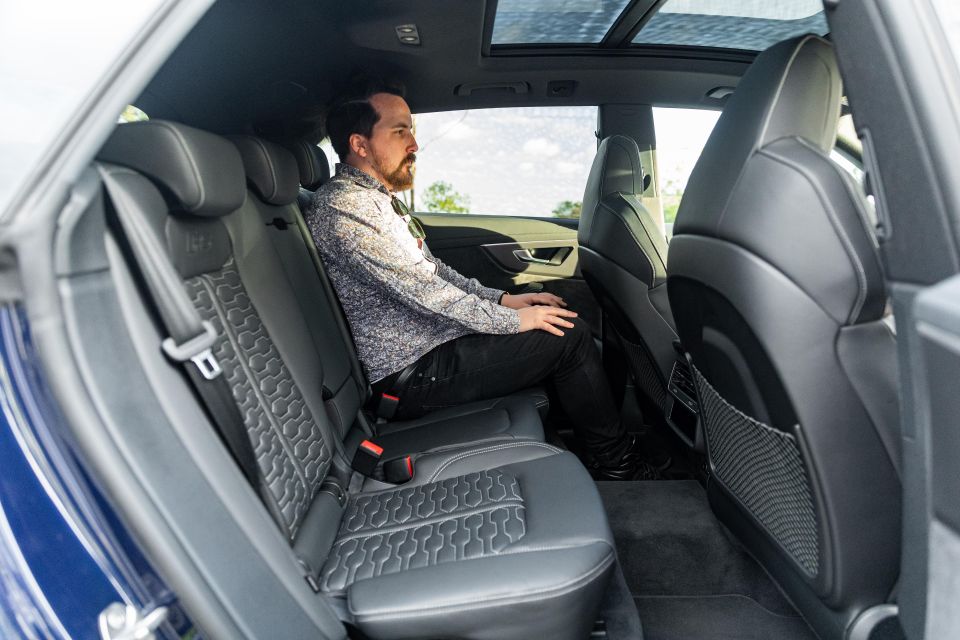

Rear-seat occupants have a small screen via which their climate control settings can be adjusted, while there are also two USB-A outlets and a 12V outlet.
Open the tailgate and there’s a spacious cargo bay. The RSQ8 has 605L of luggage space, expanding to 1755L with the rear bench folded.
Build quality is hard to fault but for one recurring issue we had: the panoramic sunroof. Occasionally, particularly on coarser-chip surfaces, the glass would rattle. Audi isn’t the only brand we’ve experienced this issue with, but that doesn’t make it any more acceptable. I can’t stand it on my car, which cost around $80,000 new, so it can’t be tolerated on a car costing over $200,000.

The RSQ8 is powered by the same twin-turbocharged 4.0-litre petrol V8 engine as the Audi RS6 and RS7. It produces 441kW of power at 6000rpm and 800Nm of torque between 2200 and 4000rpm, good for a 0-100km/h time of 3.8 seconds. That’s only 0.2 seconds off the RS6 and RS7.
For reference, an AMG GLE63 puts out 450kW and 850Nm while an X6 M produces 460kW and 750Nm. The Lamborghini Urus pumps out 478kW and 850Nm, not as wide a gulf as you might expect given its 50 per cent higher price.
The V8 is mated with an eight-speed torque-converter automatic transmission and all-wheel drive.
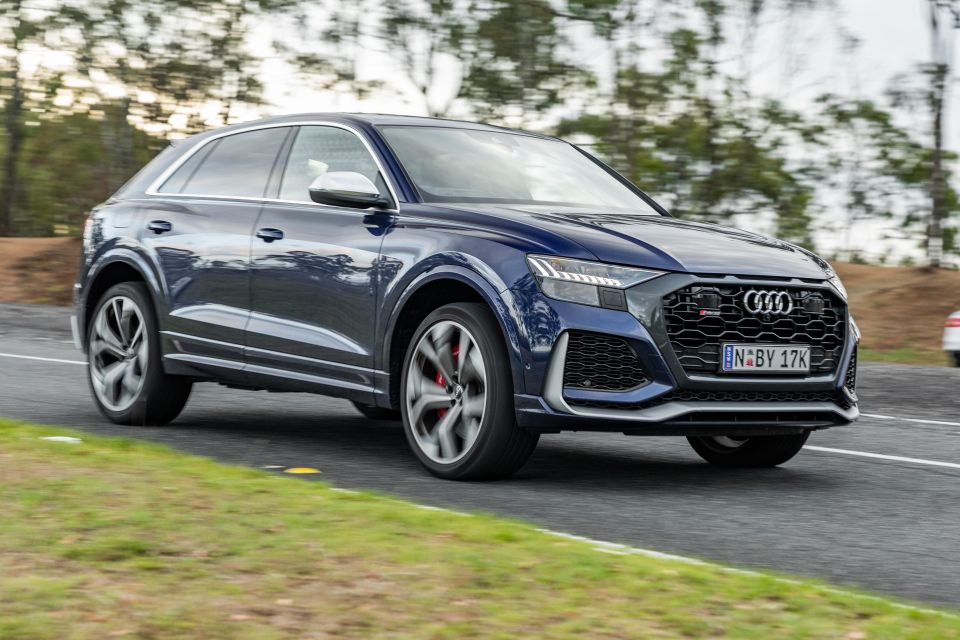
It’s impressive how something with such enormous wheels and low-profile tyres can ride so well. You can chalk that up to the adaptive air suspension, which provides a tremendous level of adjustability.
Even in Dynamic mode, there isn’t a busy, terse feel to the RSQ8’s ride, with only a succession of bumps and ruts on a particularly pockmarked street or rural road resulting in a somewhat choppy ride.
You can choose between Off-Road, Allroad, Efficiency, Comfort, Auto and Dynamic drive modes, as well as customisable RS modes that allow you to tailor the suspension, steering, throttle response and vehicle sound. Dynamic is still comfortable enough to drive around town in. It doesn’t add too much artificial weight to the steering but it lowers the ride height and amplifies the RSQ8’s sound.
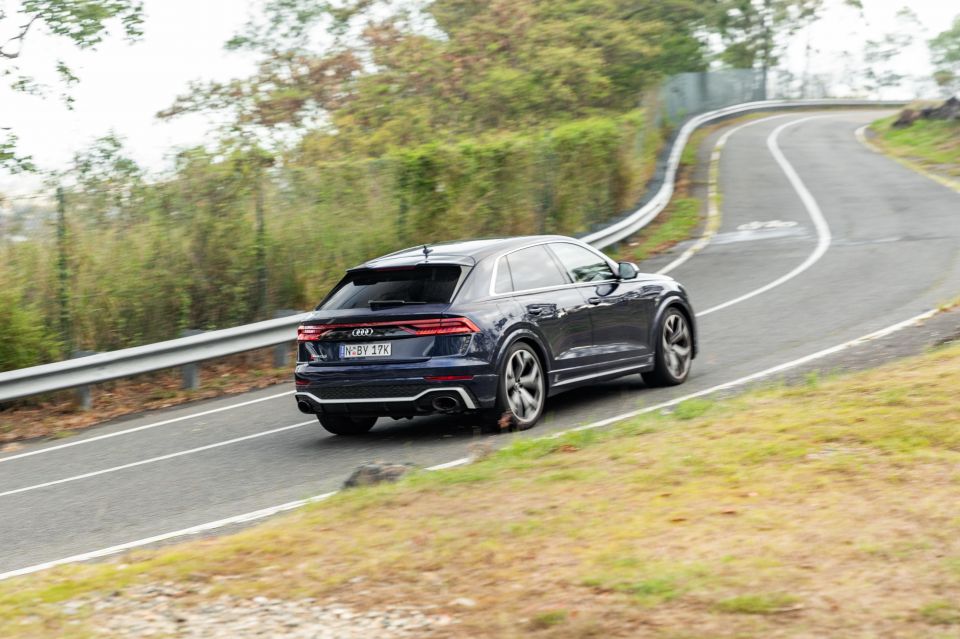
Where expert car reviews meet expert car buying – CarExpert gives you trusted advice, personalised service and real savings on your next new car.
If there’s one area in which the RSQ8 is lacking, it’s the sound department. We can’t blame Audi too much here as, like so many other automakers, it’s hamstrung by European noise regulations and emissions standards.
Nevertheless, it’s frustrating that even in Dynamic mode, the mighty twin-turbocharged V8 sounds subdued. Only a firm prod of the accelerator truly releases the delectable metallic sound of the bent-eight. It’s almost like these silenced internal-combustion engines exist to prepare us for electric vehicles.
For what it’s worth, people standing outside the RSQ8 commented on how lovely it sounded. We just wish there was a more extreme RS drive mode that could bring more of that sound inside.
That the RSQ8 is so quiet is both good and bad news. The bad news is it isn’t possible to enjoy a truly lovely throbbing, rumbling engine and exhaust sound, something you might expect from a vehicle with the RS badge. The flip side is it makes the RSQ8 a refined companion, especially when you consider how pliant the ride is and how comfortably-weighted the steering is. It’s also whisper-quiet on the highway.
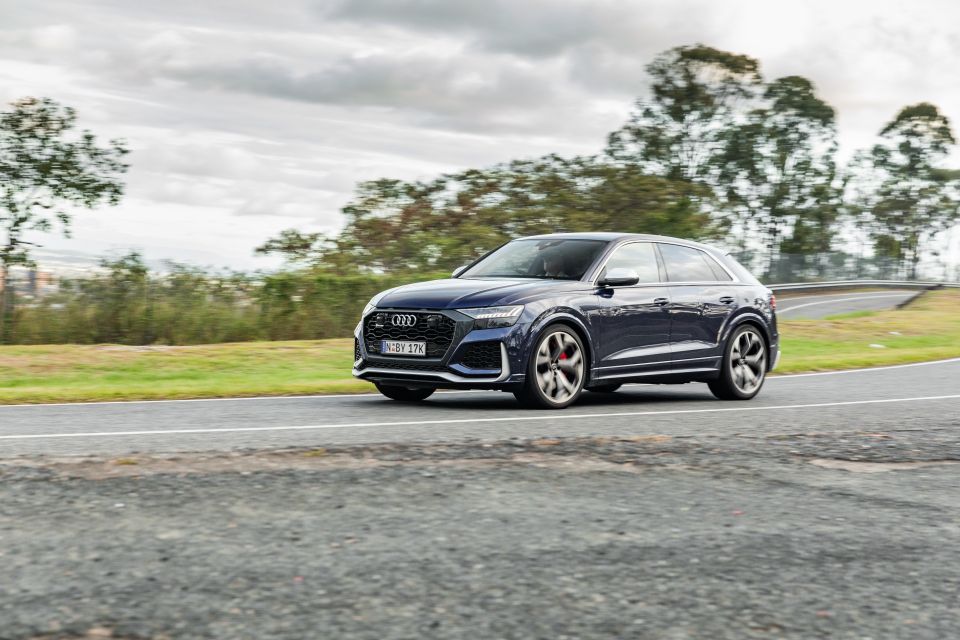
If you’re expecting the RSQ8 to be ferocious all the time, you’d perhaps be better served by an Urus. The RSQ8 is properly quick, of course, but there isn’t a hyperactive quality to its road manners, which means this is a superb long-distance cruiser and a capable commuter.
We can’t use the cliche this vehicle “shrinks around you”. This is a 2535kg (tare) SUV measuring 5m long, and the Audi can never fully conceal that girth. However, there’s an ease with which the RSQ8 drives that makes this a surprisingly comfortable vehicle for the private school run, from its well-weighted steering to its pliant ride.
Take it to a winding road and the lowered Dynamic mode is worth its weight in gold, keeping the car hunkered down and making body roll virtually non-existent. Credit, too, must go to the active roll stabilisation and four-wheel steering for making this bulky SUV feel far more nimble than it ought to.
The twin-turbo V8 just pulls and pulls and the eight-speed automatic transmission is superbly matched, so much so you’ll never bother to reach for the paddle shifters. Even in Dynamic mode, it rarely holds a gear for longer than needed.
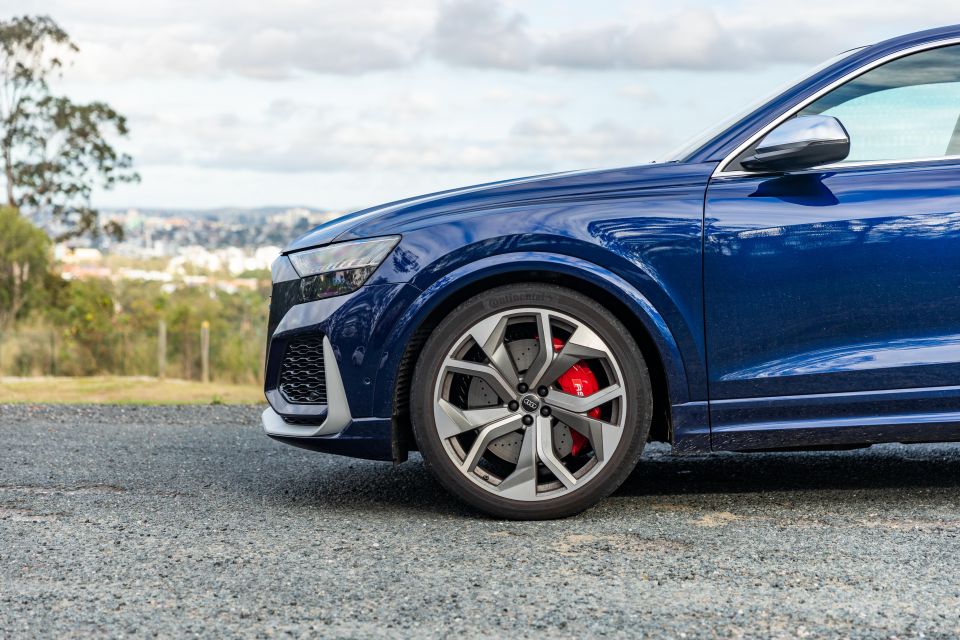
Put it back into Comfort mode and any edge is taken off the car, as if it’s been very lightly sedated. It’s pleasant, though, if you’re just cruising around town, with softer throttle response and a plush ride that avoids feeling too floaty.
The Matrix LED headlights are superb, while the driver assist systems proved merely adequate. The lane-keep assist isn’t the most proactive, while the adaptive cruise control proved surprisingly gun-shy even with the minimum distance set.
It’s worth noting the lane-keep assist can be easily toggled on and off via a button at the end of a stalk, while other driver assist systems are managed via the touchscreen.
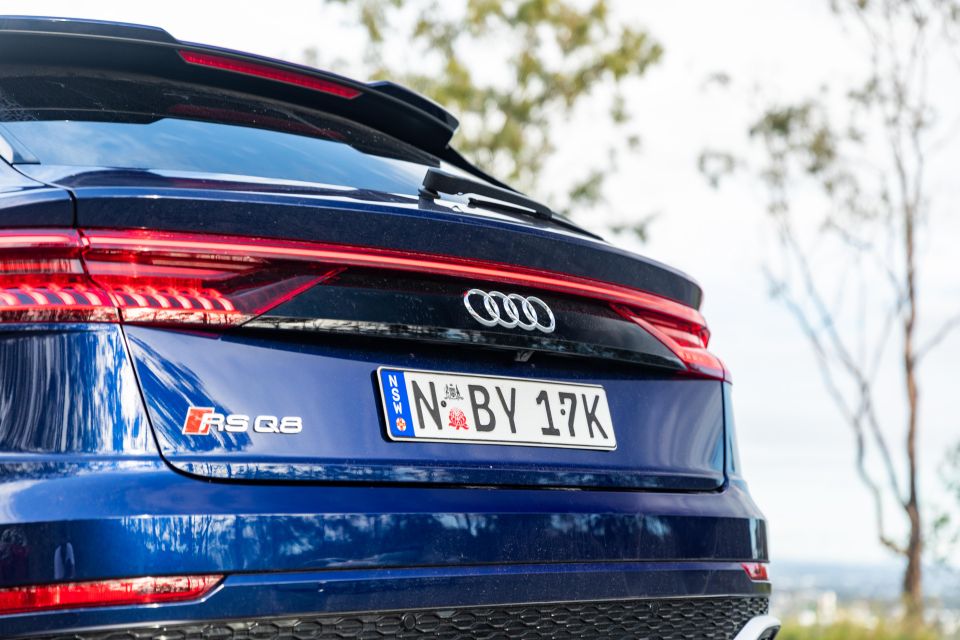
Over our fuel economy loop, comprising a mix of inner-city, suburban and highway driving, we averaged 15.6L/100km. Over the course of a week with the car, this settled down to 14.8L/100km. That’s higher than the claimed combined cycle rating of 12.1L/100km, however it’s hard not to take advantage of that lovely twin-turbo V8.
Audi has yet to follow the likes of Mercedes-Benz and Jaguar to a permanent five-year, unlimited-kilometre warranty. Instead, it offers a three-year, unlimited-kilometre warranty.
Servicing is required every 12 months or 15,000km, and Audi offers a five-year servicing plan priced at $4180.
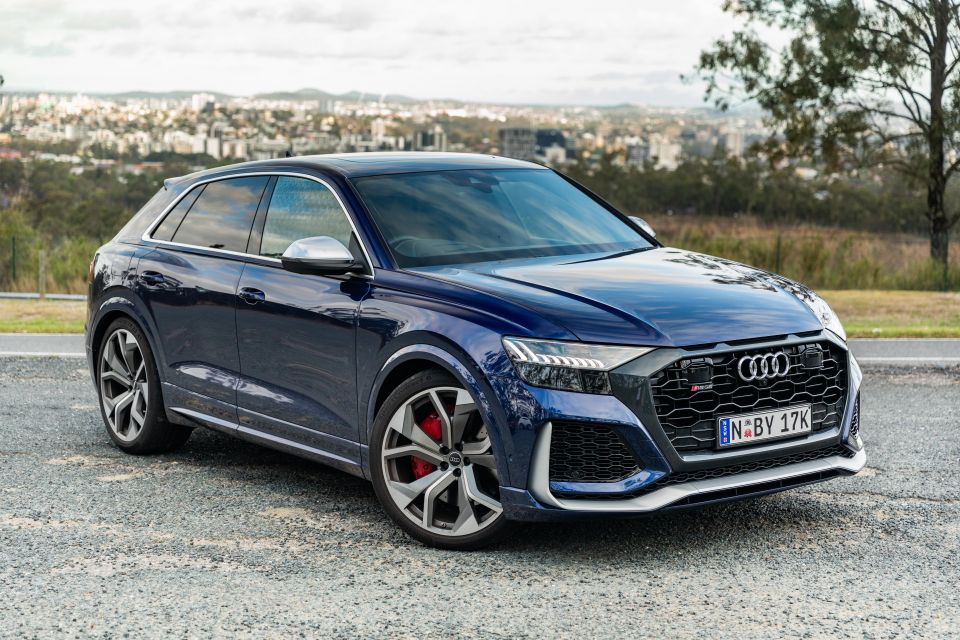
Buy your new car without the stress. It's fast, simple and completely free.

Great service from Travis and team, second time I have used this business would not hesitate to recommend them to anyone
Craig C.
Purchased a Ford Ranger in Sunshine Coast, QLD
CarExpert helped Craig save $7,224 on his Ford Ranger, now let us save you on your next new car.
Get your BEST priceYou might be expecting something more wild from a model wearing Audi’s RS badge, but that doesn’t mean the RSQ8 is a let-down.
Instead, this is a comfortable, well-appointed SUV with a crackerjack engine and plenty of dynamic nous.
There’s a real duality of purpose here, with the RSQ8 proving a comfortable commuter in Comfort or Auto modes and a surprisingly enjoyable corner carver in Dynamic mode. If only the latter mode brought with it a louder V8 soundtrack…
There’s little practical benefit in getting the RSQ8 over an RS6, however, and Audi’s fiery wagon features an almost identical interior, a spacious load bay, and sexy looks for a wagon. So while you may be determined to buy an SUV, the RS6 is worth the few thousand dollars more for an even more engaging drive.
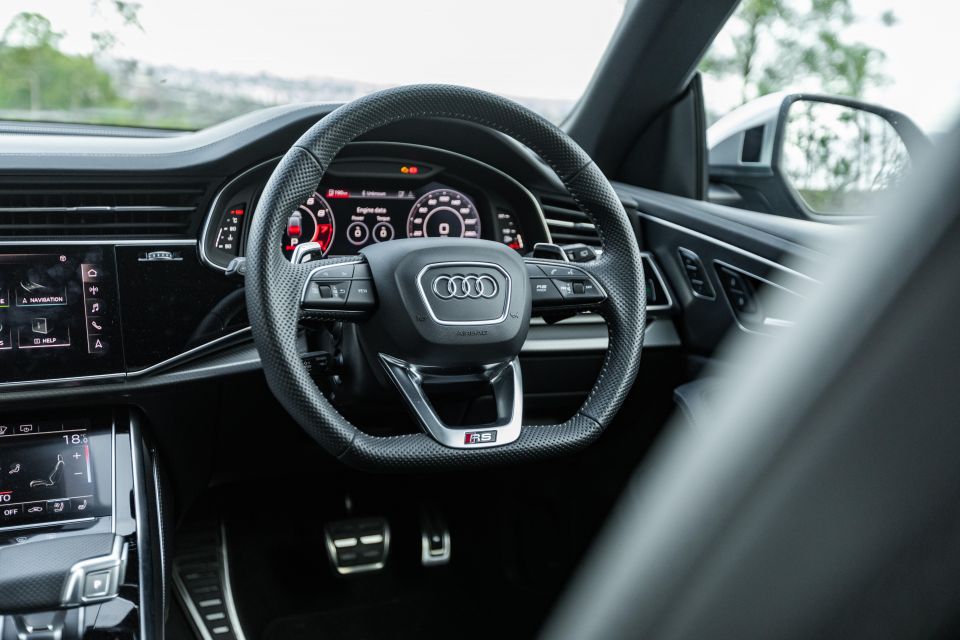
Click the images for the full gallery
MORE: Everything Audi RSQ8
Where expert car reviews meet expert car buying – CarExpert gives you trusted advice, personalised service and real savings on your next new car.
William Stopford is an automotive journalist with a passion for mainstream cars, automotive history and overseas auto markets.


William Stopford
4 Hours Ago
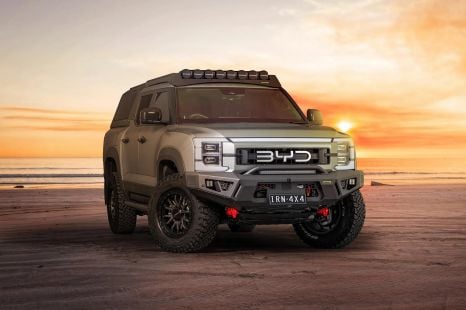

William Stopford
13 Hours Ago
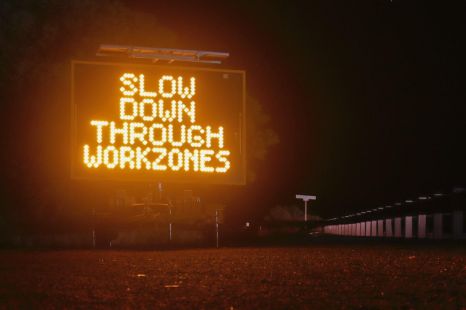

Ben Zachariah
15 Hours Ago
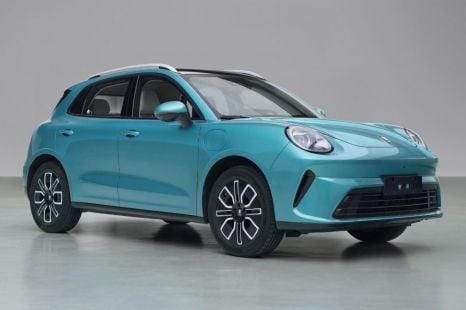

William Stopford
15 Hours Ago
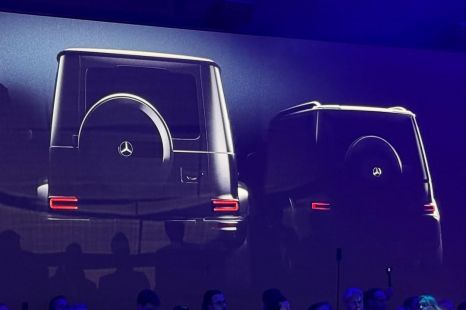

Ben Zachariah
18 Hours Ago
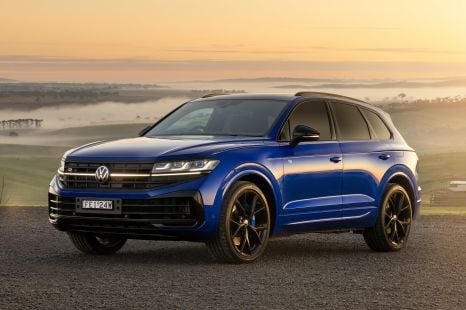

Damion Smy
18 Hours Ago